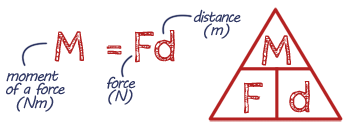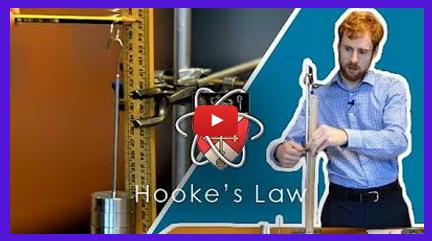
Forces
When you push or pull something, you apply force to it. This force can make things speed up, slow down, change direction, or even squish or stretch them. In simple terms, force is just something that makes things move or change shape.
Equations on this page:
Work Done with Force, Elastic Potential Energy, Gravitational Field Strength, Force applied to a Spring and Moment
Practicals on this page:
Investigating Springs
What are vector and scalar forces?
A vector force is a force that has both size (magnitude) and direction. Imagine you're giving directions to a friend to find a hidden treasure. You not only tell them how far to walk (the size) but also which direction to go (the direction). Similarly, a vector force tells you both how strong a force is and in which way it's acting.
For example, when you kick a football, you apply force to it. This force has a magnitude (how hard you kick) and a direction (the direction in which you kick). Both are important to understand how the football will move.
A scalar force is a force that has only size (magnitude) and no specific direction associated with it. Imagine you're measuring the temperature outside. You might say it's 25 °C. This temperature doesn't have a direction; it's just a number telling you how hot or cold it is.
Similarly, a scalar force tells you only how strong the force is but not in which direction it's acting.
What is contact and non-contact forces?
Contact forces happen when two objects physically touch each other. Imagine pushing a book across a table. Your hand is directly touching the book, so the force you apply is a contact force.
Non-contact forces can act even when objects are not touching each other. The most common non-contact force is gravity. Gravity pulls objects towards each other without any direct contact. For example, the Earth pulls objects towards its centre due to gravity, which is why things fall down. Another example is magnetism. If you bring a magnet close to a piece of iron, it will attract the iron without touching it.
What is the difference between mass and weight?
Mass is measured in kilograms (kg) or grams (g). It doesn't change wherever you go. So, if you have a bag of apples with a mass of 1 kilogram, it will still be 1 kilogram whether you're on Earth, the Moon, or Mars.
Weight is how heavy something feels due to gravity pulling on it. It's like the force you feel when you hold that bag of apples. If you hold it on Earth, you feel a certain weight. If you go to the Moon, you'd feel lighter because the gravity there is weaker.
Mass and weight are directly proportional. If you double the mass the weight will also double.
Key Words
Interaction pair - a pair of forces that are equal and opposite and act on two interacting objects.
Gravitational Force - the force of attaction between masses.
Resultant Force - the overall force on a point or object.
Equilibrium - when the forces on an object are balanced.
Moment - the turning effect of a force.
Levers - increase the distance from the pivot at which the force is applied.
Gears - circular discs with 'teeth' that transmit rotational effects.
Also see Motion, Force & Motion, Pressure.
Revision Notes

The Cornell method is like a supercharged note-taking system that helps you ace your revision!
Print out our blank revision notes pages to help you revise.
How to make effective revision notes with the Cornell method.
Exam Questions & Answers

Download and print off practice our FREE worksheet with exam style questions on Cell Biology.
EQUATION - Work Done with force
Work is done when you apply a force to move something.
Imagine you're pushing a box across the floor. If you apply force and the box moves, you're doing work. The key components are force and movement.
The amount of work done depends not just on how hard you push (force), but also on how far the box moves (distance). The formula for work (W) is:
EQUATION - Elastic Potential Energy
If an object is being stretched or squashed, it has energy in its elastic potential energy store.

EQUATION Gravitational Field Strength
Gravitational field strength is a measure of the force of gravity acting on an object per kilogram of its mass. It tells us how strong gravity is at a particular location.

EQUATION Force applied to a spring (Hooke's Law)
When a force is applied to a spring, it can stretch or compress. The amount it stretches is directly proportional to the force applied, as long as the spring isn't stretched beyond its limit. This is described by Hooke’s Law, which is: Force = Spring Constant × Extension. The spring constant tells you how stiff the spring is, and the extension is how much it stretches from its original length.

EQUATION Moment
A moment is the turning effect of a force around a fixed point, known as the pivot. It explains how forces cause objects to rotate. The size of the moment depends on both the size of the force and how far it is applied from the pivot.

PRACTICAL Investigating Springs
In this practical, you investigate how the extension of a spring changes when different forces are applied. You’ll hang weights from a spring, measure how much it stretches, and record your results.
By plotting a graph of force against extension, you can see if the spring follows Hooke’s Law — which states that the extension is directly proportional to the force, as long as the spring’s elastic limit is not exceeded.
Links for Learning
Bitesize: Scalar & vector quantities.
Pass my exams: Scalar & Vector quantities.
Bitesize: Contact & non-contact forces.
Bitesize: Gravity.
Bitesize: Forces & elasticity.
Bitesize: Moments, levers and gears.
Bitesize: Scalar and vector quantities test.
Bitesize: Contact and non-contact forces test.
Bitesize: Gravity test.
Bitesize: Forces & elasticity.
Bitesize: Moments, levers and gears.
Revision Notes

The Cornell method is like a supercharged note-taking system that helps you ace your revision!
Print out our blank revision notes pages to help you revise.
How to make effective revision notes with the Cornell method.
Why Do I Need to Know About Forces?
In Everyday Life
- Understanding how forces push, pull, stretch, or squash objects—like when you open a door or press a button
- Recognising why things speed up, slow down, change direction, or stay still, based on the balance of forces
- Learning how weight, gravity, and mass are connected—and why you feel lighter on the Moon or the top of a mountain
- Knowing how levers, gears, and moment work helps you understand everyday tools like scissors, wheelbarrows, and wrenches
- Appreciating why seatbelts, helmets, and safety features in cars protect us by managing forces—even when things go wrong
In Science & Physics Careers
- Designing machines and structures that must withstand forces and loads—from buildings to bridges to roller coasters
- Understanding elasticity, stress, and strain is essential in engineering, materials science, and technology design
- Applying principles of moments and equilibrium to design efficient mechanical systems and safety equipment
- Using knowledge of forces and motion in fields like robotics, automotive engineering, and aeronautics
- Working with sensors and measurements of force, pressure, and torque in scientific research, manufacturing, and product testing







